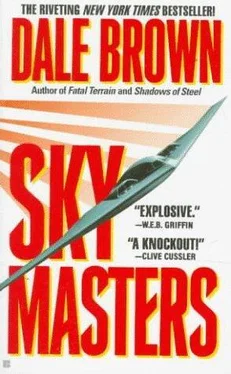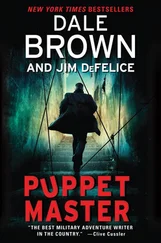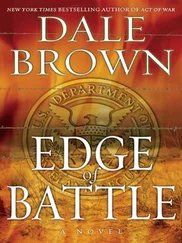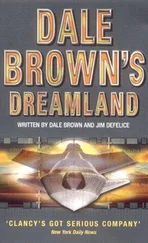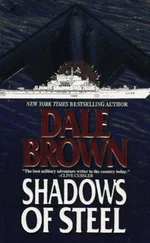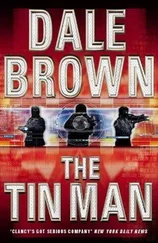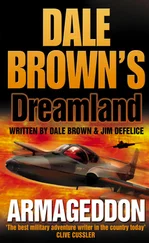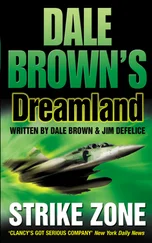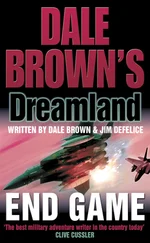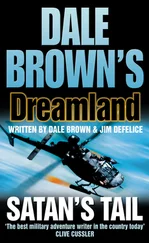Dale Brown - Sky Masters
Здесь есть возможность читать онлайн «Dale Brown - Sky Masters» весь текст электронной книги совершенно бесплатно (целиком полную версию без сокращений). В некоторых случаях можно слушать аудио, скачать через торрент в формате fb2 и присутствует краткое содержание. Жанр: Старинная литература, на английском языке. Описание произведения, (предисловие) а так же отзывы посетителей доступны на портале библиотеки ЛибКат.
- Название:Sky Masters
- Автор:
- Жанр:
- Год:неизвестен
- ISBN:нет данных
- Рейтинг книги:4 / 5. Голосов: 1
-
Избранное:Добавить в избранное
- Отзывы:
-
Ваша оценка:
- 80
- 1
- 2
- 3
- 4
- 5
Sky Masters: краткое содержание, описание и аннотация
Предлагаем к чтению аннотацию, описание, краткое содержание или предисловие (зависит от того, что написал сам автор книги «Sky Masters»). Если вы не нашли необходимую информацию о книге — напишите в комментариях, мы постараемся отыскать её.
Sky Masters — читать онлайн бесплатно полную книгу (весь текст) целиком
Ниже представлен текст книги, разбитый по страницам. Система сохранения места последней прочитанной страницы, позволяет с удобством читать онлайн бесплатно книгу «Sky Masters», без необходимости каждый раз заново искать на чём Вы остановились. Поставьте закладку, и сможете в любой момент перейти на страницу, на которой закончили чтение.
Интервал:
Закладка:
“Continuous faults on the nozzle, ” Kaddiri replied. “It’s maintaining course, but it might slip out of stage-three tolerance limits.” The third-stage section of the booster was much smaller than the first two stages, designed only to increase the booster’s velocity to Mach 25 for orbital insertion; it could not perform large course corrections. If the second-stage motor could not hold the booster within a gradually narrowing trajectory corridor, the booster could slip into a useless and possibly dangerous orbit. Numerous “safe” orbits were computed where the NIRTSat satellites would not interfere with other spacecraft and where they could be “stored” until it was possible to retrieve them, but it was usually very difficult to place a malfunctioning booster into a precomputed “safe” orbit. If it could not be placed in a position where it was not a hazard to other satellites, it could damage or destroy dozens of other payloads and re-enter the atmosphere over a populated area. Before that could be allowed tohappen, they would destroy it. That was exactly what Foch had in mind as he opened the plastic-guarded safety cover on the command destruct panel. Foch, Kaddiri, Masters, and the ground safety officers at the White Sands range could command the ALARM booster to self-destruct at any time; now that the booster was flying, Masters had very little authority over its disposition-he could not override a “Destruct” command. “I told you this might happen, Doctor Masters, ” Foch said. “The booster was obviously shaken off course by the strong, high-altitude winds, and it sustained some damage and can’t correct its course enough.” But Masters sat back and, to everyone’s surprise, put his feet up on the control console. “Ten seconds to second-stage burnout, ” he said, sipping his soda. “Sit back, relax. It’ll stay in the groove long enough.”
“The decision doesn’t rest with you this time, Masters, ” Foch fumed. “The command’ll come from White Sands or the Air Force Space Tracking Center. White Sands will initiate the destruct sequence. If their command doesn’t work, I initiate mine.”
“Well, well.. .” Masters laughed, pointing to the computer monitor. Foch turned to look. “Second-stage burnout, and Roosevelt-One is still on course.” They studied the readouts for a few more moments. The booster, headed into a polar orbit over Canada, was picked up by Alaskan radar sites as it continued its climb to its orbit altitude. Soon its orbital insertion would be picked up by space-tracking radars at San Miguel Air Force Station in the Philippines, and the NIRTSats would begin their work. After a while, Masters turned to Foch with a smug expression. “Minor course corrections being made, but it’s right on course. Expect third-stage ignition in four minutes.” He took another big Sip of soda, then punctuated his victory with a loud burp. “I’d get your finger away from that destruct button if I were you, Colonel. The Navy wouldn’t appreciate you blowing up a perfectly good booster.” CLARK AIR BASE, ANGELES, PAMPANGA PROVINCE REPUBLIC OF THE PHILIPPINES PHILIPPINES INDEPENDENCE DAY SUNDAY, 12 JUNE 1994, 1147 HOURS LOCAL One of the first major uses of Masters’ new NIRTSat constellation of real-time position and communications reporting capability for Air Force aircraft was a few days later-and it was the most inauspicious. It was the day the last of the United States Air Force’s aircraft departed the Philippines as the Americans turned over their military bases to full Filipino control. The satellites would control the last of the American fighters and tankers as they withdrew from the Philippines to bases in Japan and Guam. Headquarters of the U.S. Air Force’s Thirteenth Air Force at Clark Air Base, sixty-five miles north of Manila, was in a magnificent white six-story stucco building, at the end of a long grassy mall between the NCO and officers’ family-housing areas. Both sides of the mall along the Weston and Wirt Davis avenues had once been lined with flags of the numerous military units of several nations that had liberated the Philippines from Japan during World War II, standing as a monument to those who had died defending this island nation against the Axis. Now the sixty poles were vacant except for the three flagpoles at the head of the mall opposite the headquarters building-the flags of the Philippines, the United States, and the U.S. Air Force. From his vantage point on the review stand in front of the headquarters building, Major General Richard Stone noticed that someone had lowered the American flag down several feet from the top of its staff-it almost appeared to be at half staff. Perhaps it should be so. Stone’s aide, Colonel Michael Krieg, stepped over to his boss and handed him a Teletype report. “Latest on that skirmish near the Spratlys, sir, ” Krieg said. “The Chinese are still claiming they were attacked by heavy antiship weapons. Twentyseven Filipinos dead, six Americans, and five missing.”
“Christ, ” Stone sighed. He had watched the repercussions build over the last week since the skirmish. “Do the Chinese expect anyone to believe that? Why the hell would an oil company have any antiship missiles on an oil-exploration platform?”
“They did have machine guns, sir. Twenty-millimeter. World War Two vintage American Mk 4. Pretty good operating condition, too-before the Chinese melted it with a Fei Lung-7.”
“Idiots, ” Stone muttered. “Opening up on a warship like that. So what are the Chinese doing now?”
“Laying low, ” Krieg replied. “Only occasional incursions in the Spratly Island neutral zone. President Mikaso’s government is being very understanding about it so far. Vice President Samar issued a statement calling for reparations from the Chinese.”
“Lots of luck.” “Vice President Teguina called for an investigation-not of the Chinese, but of Mikaso’s government, ” Krieg added. “Of Mikaso $ government? Not the Chinese? ‘Coursethat’s typical, ” Stone said. “Whatever it takes to distance himself from Mikaso.. . just as he’s always done. Anything for a headline.”
“The little bastard’s got balls, that’s for sure. Major General Stone grunted. “You can say that againTeguina loves to stir things up. Now, what do we have out there keeping an eye on things?” Krieg looked at his boss with a look of pure concern. “In two hours-nothing.”
“What?” “Message from CINCPAC.” CINCPAC was the acronym for Commander in Chief Pacific Command, the U.S. military organization responsible for all military activities from the West Coast of the United States to Africa. “He wants no combat aircraft or vessels near the area until they can get a reading from the Chinese. Strictly hands off.”
“Well, what did we have out there?” Stone grumbled, irritated at CINCPAC’s order. “A couple F-16s from here checking it out, maybe a P-3 subchaser diverted to Zamboanga Airport or Bangoy Airport near Davao-er, sorry, they call it Samar International Airport now-to take some pictures. Apparently the Chinese feel our presence is threatening. CINCPAC agreed. No more flights within fifty miles.”
“A fitting end to a perfectly lousy day, ” Stone said, straightening his uniform and heading toward the reviewing stand for the ceremony. Major General Richard “Rat” Stone was the commander of the now disbanded Thirteenth Air Force-the principal American air defense, air support, and logistics support organization in the Republic of the Philippines. General Stone-whose nickname was short for “Rat Killer” after a strafing run in his F-4 along the Ho Chi Minh Trail in Vietnam had killed dozens of rats with 20-millimeter cannon fire-commanded the twenty different organizations from five major operating commands at Clark Air Base. Principal of all the organizations on his base was the Third Tactical Fighter Wing, composed ofF- 16 fighter-bombers and F-4G “Advanced Wild Weasel” electronic warfare and defense suppression fighters; and the 6200th Tactical Fighter Training Group, who operated the various tactical training ranges and fighter weapons schools in the Philippines and who ran the seven annual “Cope Thunder” combat exercises to train American and allied pilots from all over the Pacific. The Third Tactical Fighter Wing, whose planes had the distinctive “PN” letters on the tail plus either the black “Peugeots” of the Third Tactical Fighter Squadron or the “Pair-O-Dice” of the Ninetieth Tactical Fighter Squadron, flew air-to-air and air-to-ground strike missions in support of American interests from Australia to Japan and from India to Hawaii. Clark Air Base had also been home to a very large Military Airlift Command contingent of C-130 Hercules transports, C-9 Nightingale flying hospitals, C- 12 Huron light transport shut tIes, and HH-53 Super Jolly and HH-3 Jolly Green Giant rescue and special-operations helicopters. The 374th Tactical Airlift Wing shuttled supplies and personnel all across the South Pacific and would, in wartime, deliver troops and supplies behind enemy lines. The Ninth Aeromedical Evacuation Squadron, the Twentieth Aeromedical Airlift Squadron, and the Thirty-first Aerospace Rescue and Recovery Squadron all provided medical airlift support and would fly rescue missions over land or water to recover downed aircrews-these were the organizations that first welcomed the American prisoners of war from Vietnam in 1972. Clark also housed the 353rd Special Operations Wing, whose MC-130E Combat Talon aircrews trained to fly psychological warfare, covert resupply, and other “black” missions all across the Pacific. The base also supported the other American and Filipino military installations, including Subic Bay Naval Station, Sangley Point Naval Station, Point San Miguel Air Force Station, Camp O’Donnell, Camp John Hay, Wallace Air Station, Mount Cabuyo, Mactan Airfield, and dozens of Philippine Coast Guard and National Guard bases. In essence, Clark Air Base had been a vital link to the Pacific and a major forward base for the United States and its allies since it opened in 1903. Now it was all being handed back to the Philippineshanded back to them during some of the most volatile and dangerous times in the country’s history. Stone’s gaze moved from his country’s flag to the throngs of noisy protesters outside the perimeter fence less than a kilometer away. At least ten thousand protesters pressed against the barbed wire-topped fences, shouting anti-American slogans and tossing garbage over the brick wall; Stone had arranged armored personnel carriers every one hundred yards along the wall surrounding the base to counter just such a demonstration. The Americans inside those carriers were armed only with sidearms and tear-gas-grenade launchers, and the Filipino troops and riot police outside the gates had nothing more lethal than fat rubber bullets. They were being pelted by rocks and bottles so badly that the carrier’s crews dared not poke their heads out or even open one of the thin eye-portals. The throngs could easily overrun them all if they were stirred up. Occasionally a shot could be heard ringing out over the din of the crowd. Stone realized that, after weeks of these protests, he no longer jumped when he heard the gunfire. The Thirteenth Air Force commander had aged far beyond his fifty years in just the last few months. Of no more than medium height, with close-cropped silver hair, piercing blue eyes, broad shoulders narrowing quickly to a trim waist, and thin racehorse ankles, Stone was a soft-spoken yet energetic fighter pilot who had risen through the ranks from a “ninetyday-wonder” Officer Training School pilot candidate during the Vietnam War to a two-star general and commander of a major military installation defending a principal democratic ally and guarding America’s western flank. In the past year, however, he had found himself supervising a degrading, ignoble withdrawal from the base and the country he had learned to love so well. It was deeply depressing. From a contingent of nearly eleven thousand men and women only twelve months earlier, Stone had assembled the last remaining two hundred American military personnel on the mall in front of the reviewing stand, to march one last time in parade. Although there were supposed to be ten persons from each of the twenty resident and tenant organizations on the base, Stone knew that most of the two hundred men and women who marched before him were security policemen, who had been hand-picked to ensure the safety of General Stone and the other Americans from Clark AB as they departed that day. Part of the reason for the huge demonstration outside the perimeter fence was the presence of the two Filipino men on the reviewing stand with Stone: Philippine President Arturo Mikaso, and First Vice President Daniel Teguina. Teguina had carried the cry for the Philippines to cut all ties with the West and to not renew the leases on American military bases. Unlike the refined and elderly Mikaso, Daniel Teguina liked to be in the public eye, and he carefully polished his image to reflect the young radical students and peasants that he believed he represented. He dressed in more colorful, contemporary clothes, dyed his hair to hide the gray, and liked to appear in nightclubs and at soccer matches. The National Democratic Front, despite reputed ties to the New People’s Army, the organization that controlled the Communist-led Huk insurgents in the outlying provinces, flourished under the Mikaso-Teguina coalition government. Under Mikaso’s strong popular leadership, the military threat to the government from the extremist Communist forces subsided, but the new, more radical voices in the government were harder to ignore. It didn’t take long for a national referendum to be called after the 1994 elections, which forbade the President to extend the leases for American bases any further. The referendum passed by a narrow margin, and the United States was ordered to withdraw all permanent military forces from the Philippines and turn control of the installations to the Philippine government within six months. Second Vice President General Jose Trujillo Samar, who was not present at the ceremonies, shared the majority of Filipinos’ distaste for American hegemony, and he fought hard for removal of the bases. Leaving, Rat Stone was out of a job. Over the slowly rising screaming and yelling from the protesters, the American airmen marched in front of the reviewing stand, formed into four groups of fifty, and were ordered to parade rest by Colonel Krieg, acting as the parade adjutant general. Surrounding the grassy mall were two sets of bleachers, where guests of the government and a few American family members and embassy personnel watched with long faces the lowering of the colors for the last time over Clark Air Base. Banks of photographers, television cameras, and reporters were clustered all around the reviewing stand to capture the ceremonies. While several network news companies were on hand, no live broadcast of the ceremony was permitted. General Stone had felt, and the Air Force concurred, that a live broadcast might cause widespread demonstrations all across the country. That was also the reason no high-level American politicians were on hand. The official transfer had been made in the safety of Washington, D.C., weeks ago. President Mikaso stepped forward to the podium as a taped trumpet call was played. The crowd began to cheer, and an appreciative ripple of applause issued from the bleachers. When the music stopped, Mikaso spoke in flawless English: “My friends and fellow Filipinos, we are here to mark a historic end, and a historic beginning, in the relations between the Republic of the Philippines and the United States of America. On this day of freedom and independence, we also mark a significant milestone in the future of the Philippines. “For over ninety years, we have relied on the courage, the generosity, and the strength of the people of the United States for our security. Such an arrangement has greatly benefited our country and all its people. For this, we will be eternally grateful. “But we have learned much over these long years. We have studied the sacred values of democracy and justice, and we have strived to become not just a dependency of our good friends in the United States, but a strong, trusted ally. We are here today to celebrate an important final stage of that education, as the people of the Philippines take the reins of authority of our national security responsibilities. We are thankful for the help from our American friends, and we gratefully recognize the sacrifices you have made to our security and prosperity. With your guidance and with God’s help, we take the first great step toward being a genuine world power. . Mikaso spoke eloquently for several more minutes, and when he was done, appreciative applause made its way from the bleachers all the way out beyond the wall, over the crowds. The people clearly loved their President. But Teguina listened to the speech and Mikaso’s praise for the United States with growing impatience and disgust. He loathed the Americans and had always resented their presence. As for Mikaso, he owed him nothing. He’d agreed to this hybrid coalition only after he’d realized he didn’t have enough votes to win the presidency himself. As taped music was played over the PA system, Mikaso, Stone, and, reluctantly, Teguina, positioned themselves in front of a special set of three flagpoles behind the reviewing stands. An honor guard stepped onto the stand and positioned themselves around the flagpoles. As Mikaso placed a hand over his heart in tribute, the Philippine flag was lowered a few feet in respect. Then, as “Retreat” was played, the American flag was raised to the top of the staff, then slowly lowered. “Why is our flag lowered?” Teguina whispered, as if to himself. When no one paid him any attention, he raised his voice: “I ask, why is the Philippine flag lowered first? I do not understand “Silence, Mr. Teguina, ” Mikaso whispered. “Raise the Philippine flag back to the top of the staff, , ” he said, his voice now carrying clearly over the music. “It is disrespectful for any national flag to be lowered in such a way. “We are paying honor to the Americans-“
Читать дальшеИнтервал:
Закладка:
Похожие книги на «Sky Masters»
Представляем Вашему вниманию похожие книги на «Sky Masters» списком для выбора. Мы отобрали схожую по названию и смыслу литературу в надежде предоставить читателям больше вариантов отыскать новые, интересные, ещё непрочитанные произведения.
Обсуждение, отзывы о книге «Sky Masters» и просто собственные мнения читателей. Оставьте ваши комментарии, напишите, что Вы думаете о произведении, его смысле или главных героях. Укажите что конкретно понравилось, а что нет, и почему Вы так считаете.
